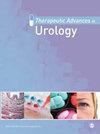评估来伐替尼和依维莫司治疗晚期肾细胞癌的有效性和安全性:从RELIEVE研究对重度预处理患者的分析中获得的启示
IF 3.5
4区 医学
Q2 UROLOGY & NEPHROLOGY
引用次数: 0
摘要
背景:对接受过大量预处理的转移性肾细胞癌(mRCC)患者的治疗是一项尚未满足的医疗需求,目前仍面临挑战。目标:首要目标是评估来伐替尼联合依维莫司的疗效,次要目标是评估这种联合疗法的毒性概况。设计:我们进行了一项纵向回顾性研究,考察了意大利不同癌症中心接受过一线或多线治疗的mRCC患者。方法:研究纳入了接受来伐替尼联合依维莫司二线治疗或二线以上治疗的患者。我们评估了无进展生存期(PFS)、治疗失败时间(TTF)、总生存期(OS)、反应率(RR)和毒性概况。此外,我们还探讨了治疗效果与临床和实验室参数之间的潜在关系。结果:总共有 33 名患者接受了评估,中位年龄为 60 岁,57% 的患者在东部合作肿瘤学组的表现状态为 1-2 级,63% 的患者接受了ɳSm_273↩治疗。63%的患者之前接受过⩾3种治疗。根据国际转移性肾细胞癌数据库联盟(International Metastatic Renal Cell Carcinoma Database Consortium),62%的患者属于 "中危",30%属于 "低危"。RR为42%(无完全反应),18%病情稳定。中位OS为11.2个月(95% CI 6.8-19.9),中位PFS为6.7个月(95% CI 0.6-30.8),中位TTF为6.7个月(95% CI 4.8-16.6)。较短的OS与淋巴结转移(p = 0.043,95% CI)、中性粒细胞/淋巴细胞比值(NLR)⩾ 3(p = 0.007)、血红蛋白/红细胞分布宽度比值截断值<0.7显著相关(p = 0.03),而较短的PFS与肺转移(p = 0.048)和脑转移(p = 0.023)相关。最常见的G1毒性为腹泻(24%),G2为疲劳(30%),G3为高血压和皮肤毒性(6%)。本文章由计算机程序翻译,如有差异,请以英文原文为准。
Assessing the effectiveness and safety of lenvatinib and everolimus in advanced renal cell carcinoma: insights from the RELIEVE study’s analysis of heavily pretreated patients
Background:The treatment of heavily pretreated patients with metastatic renal cell carcinoma (mRCC) represents an unmet medical need and is still challenging.Objectives:The primary objective was to assess the effectiveness of the lenvatinib plus everolimus combination and the secondary objective was the toxicity profile of this combination.Design:We conducted a longitudinal retrospective study examining mRCC patients pre-treated with one or more lines of therapy among different cancer centers in Italy.Methods:The study included patients who received the combination of lenvatinib plus everolimus as either a second-line treatment or beyond. We assessed progression-free survival (PFS), time to treatment failure (TTF), overall survival (OS), response rate (RR), and toxicity profile. In addition, we explored the potential relationship between treatment effectiveness and clinical and laboratory parameters.Results:In all, 33 patients were assessed, the median age was 60 years, 57% had an Eastern Cooperative Oncology Group performance status of 1–2 and. 63% received ⩾ 3 prior lines of therapy. 62% were ‘intermediate risk’ according to the International Metastatic Renal Cell Carcinoma Database Consortium and 30% were ‘poor risk’. The RR was 42% (no complete response), 18% stable disease. Median OS was 11.2 months (95% CI 6.8–19.9), median PFS was 6.7 months (95% CI 0.6–30.8), and median TTF was 6.7 months (95% CI 4.8–16.6). A shorter OS was significantly associated with lymph node metastases ( p = 0.043, 95% CI), neutrophils/ lymphocytes ratio (NLR) ⩾ 3 ( p = 0.007), hemoglobin/red cell distribution width ratio cutoff value <0.7 was significant ( p = 0.03) while a shorter PFS was associated with lung ( p = 0.048) and brain metastases ( p = 0.023). The most frequent G1 toxicity was diarrhea (24%), G2 was fatigue (30%), and hypertension and skin toxicity (6%) for G3.Conclusion:Our findings suggest a clinically relevant effectiveness of lenvatinib plus everolimus combination with an acceptable toxicity profile for heavily pretreated patients with mRCC.
求助全文
通过发布文献求助,成功后即可免费获取论文全文。
去求助
来源期刊

Therapeutic Advances in Urology
Medicine-Urology
CiteScore
3.70
自引率
0.00%
发文量
39
审稿时长
10 weeks
期刊介绍:
Therapeutic Advances in Urology delivers the highest quality peer-reviewed articles, reviews, and scholarly comment on pioneering efforts and innovative studies across all areas of urology.
The journal has a strong clinical and pharmacological focus and is aimed at clinicians and researchers in urology, providing a forum in print and online for publishing the highest quality articles in this area. The editors welcome articles of current interest across all areas of urology, including treatment of urological disorders, with a focus on emerging pharmacological therapies.
 求助内容:
求助内容: 应助结果提醒方式:
应助结果提醒方式:


